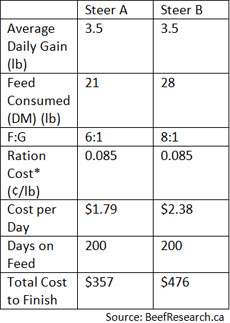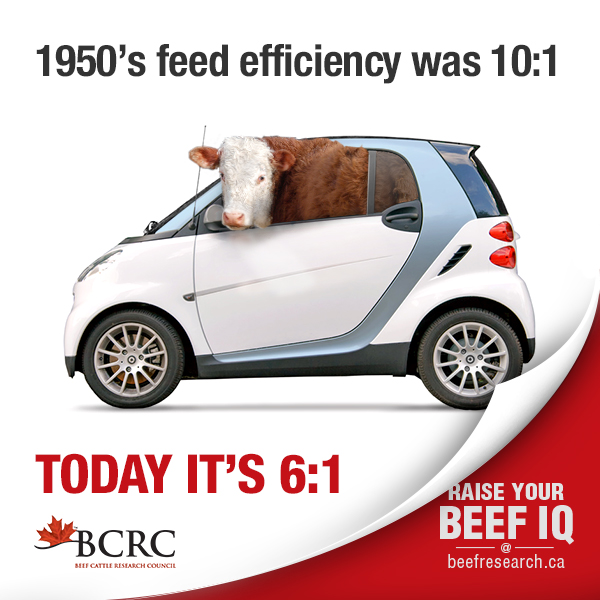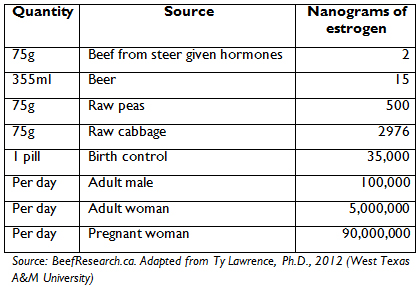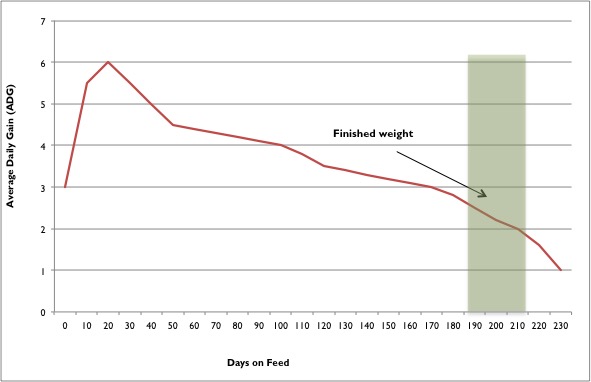What Is the Phenomen Where Thin Beef Cattle Eat More and Grow Faster?
The expenses of purchasing a calf and the feed needed to finish it are the two largest variable costs facing the cattle feeding sector. Using less feed to finish a calf would substantially improve profitability in beef production, and may diminish environmental implications. Feed costs are high due to poor growing conditions in major grain producing countries, because of the use of feed grains in ethanol production, and because of increasing competition of land for crop production versus urban development.
- Key Points
- Feed to Gain Ratio
- Progress of Feed Efficiency Research
- Diet Management
- Grain Processing
- Growth Promotants
- Ionophores
- Hormonal growth implants
- Beta adrenergic agonists
- Determining Finished Weight
- Genetics
Key Points
- The feed to gain ratio (F:G) is a key measure of efficiency. Also known as the feed conversion ratio (FCR)
- Because of the variability of water content, feed is measured by dry matter (DM).
- Steers fed higher grain diets grow faster, finish sooner, and produce heavier and fatter carcasses.
- Processing methods such as steam flaking has been shown to improve feed efficiency versus dry rolling.
- Growth promotants are among the many sophisticated tools used by feedlots and other producers to raise more beef, more rapidly, using less feed, while maintaining high standards of animal health, carcass quality and food safety. Growth promotants include ionophores, growth implants, and beta-agonists.
- Ionophores are antimicrobials (which are categorized as'Low Importance' in human medicine andare not used to treat bacterial infections in humans) delivered through cattle feed that improve nutrient availability to the animal. They can improve feed efficiency and weight gain, reduce methane production, reduce the incidence of bloat and acidosis, and prevent diseases like coccidiosis.
- Hormone growth promotant implants generally encourage protein deposition and discourage fat deposition which improves both weight gain and feed conversion.
Feed to Gain Ratio
The feed to gain ratio (F:G) is a key measure of efficiency. Also known as the feed conversion ratio (FCR), F:G is a measure of an animal's efficiency in converting feed nutrients into increased body mass. F:G is an important variable in the cost to finish an animal. Efficiency may also be expressed as gain to feed or G:F in which case a higher number is more desirable.
Because of the variability of water content, feed is measured by dry matter (DM).
 Imagine two steer calves placed on feed. Both steers are gaining an average of 3.5 pounds per day (1.59 kg/day). Over time, we measure that Steer A consumes an average of 21 lbs (9.53 kg) DM per day, which equates to a 6:1 feed to gain ratio. Steer B consumes 28 lb/day (12.70 kg/day), a F:G of 8:1, and therefore is less feed efficient than Steer A. Based on a ration cost of $187/tonne* (or 0.085 cents per pound), Steer A costs $1.79 to feed per day. Steer B costs $2.38 per day. If both steers reach their finish weight in 200 days, the less feed efficient animal (Steer B) would cost the producer $119 more to finish than an animal with better feed efficiency (Steer A). (*Note: this example may not reflect current feed costs.)
Imagine two steer calves placed on feed. Both steers are gaining an average of 3.5 pounds per day (1.59 kg/day). Over time, we measure that Steer A consumes an average of 21 lbs (9.53 kg) DM per day, which equates to a 6:1 feed to gain ratio. Steer B consumes 28 lb/day (12.70 kg/day), a F:G of 8:1, and therefore is less feed efficient than Steer A. Based on a ration cost of $187/tonne* (or 0.085 cents per pound), Steer A costs $1.79 to feed per day. Steer B costs $2.38 per day. If both steers reach their finish weight in 200 days, the less feed efficient animal (Steer B) would cost the producer $119 more to finish than an animal with better feed efficiency (Steer A). (*Note: this example may not reflect current feed costs.)
This example illustrates the importance of improving and maximizing feed efficiency in cattle on feed, which can make or break profitability in the feeding sector.
Progress of Feed Efficiency Research
Numerous research projects over the years have successfully led to substantial improvements in growth rate, days on feed, carcass weight and feed to gain.
Assuming current feed costs, a further 1% improvement in feed to gain would save the feedlot sector $11.1 million annually.
Since the 1950's, feed to gain has improved markedly due to applied research and development. Over the past 30 years, feed to gain has improved by 30%. Notable improvements were due to studies on diet management, grain processing, and growth promotants.
Diet Management
 Substituting forage with grains in finishing rations can lead to substantial improvement in feed efficiency. Steers fed higher grain diets grow faster, finish sooner, and produce heavier and fatter carcasses. Research also suggests that the type and quality of grains and the balance of essential nutrients, like vitamins, proteins, and trace minerals, significantly impact feed efficiency. Balanced rations increase average daily gain and can decrease feed cost per pound of gain. In order to prevent rumen acidosis and liver abscesses, it is necessary to appropriately adjust cattle from forage-based feed to high-energy grain-based rations.
Substituting forage with grains in finishing rations can lead to substantial improvement in feed efficiency. Steers fed higher grain diets grow faster, finish sooner, and produce heavier and fatter carcasses. Research also suggests that the type and quality of grains and the balance of essential nutrients, like vitamins, proteins, and trace minerals, significantly impact feed efficiency. Balanced rations increase average daily gain and can decrease feed cost per pound of gain. In order to prevent rumen acidosis and liver abscesses, it is necessary to appropriately adjust cattle from forage-based feed to high-energy grain-based rations.
Grain Processing
Digestibility of grains like corn, barley and oats is improved when grains are processed. Processing methods such as steam flaking has been shown to improve feed efficiency versus dry rolling. By cracking the outer shell of the grain, rumen microbes are better able to utilize grain starch and minerals. Processing also allows grain to be mixed with supplements, and affects palatability and passage rates. However, processing grains too finely leads to acidosis. Finding the ideal method and level of processing contributes to an improved F:G.
Growth Promotants
Analysis indicates that production costs would be 10% higher if producers did not use implants, ionophores or beta agonists.
Growth promotants are among the many sophisticated tools used by feedlots and other producers to raise more beef, more rapidly, using less feed, while maintaining high standards of animal health, carcass quality and food safety. Growth promotants include ionophores, growth implants, and beta-agonists. A number of products within each category are approved for use by Health Canada's Veterinary Drug Directorate.
One study2 found that overall average daily gain was 21% higher and feed efficiency was 23% better for grain-finished cattle given both implants and ionophores compared to control cattle. Economists John Lawrence and Maro Ibarburu at Iowa State University reported that feedlot average daily gain increased when ionophores, implants, and beta-agonists were used by 3%, 16% and 16% respectively. Feed efficiency improved 4% with ionophores, 10% with implants, and 14% with use of beta-agonists.
Ionophores
Ionophores are antimicrobials delivered through cattle feed that improve nutrient availability to the animal and prevent diseases like coccidiosis.
As with all refined technology, appropriate and optimal use of growth promotant products can improve animal performance and value, while improper use result in no benefit, reduced carcass value, and/or lost money.
Ionophores improve feed efficiency by acting on rumen microbes. Most rumen microbes convert the complex fiber and starch in forage and grain into simple molecules that can be absorbed into the bloodstream to provide energy and protein to the animal. Rumen bacteria known as methanogens convert the dietary fiber and starch into methane gas. Methane contains energy, but it cannot be absorbed by the animal, so it is belched out and wasted. Ionophores improve feed efficiency and weight gain by selectively inhibiting methanogenic bacteria, and allow the beneficial rumen bacteria to make more feed energy available to the animal.
Ionophores are often erroneously included in discussions about the concern of antimicrobial use in livestock and the potential link to antimicrobial resistance in humans. These antimicrobials are categorized as 'Low Importance' in human medicine, meaning they are not used to treat bacterial infections in humans, and therefore reducing or eliminating their use would have detrimental impacts on cattle production with little or no benefit for human health. When advocate groups spread statistics like "over 80 percent of all antibiotics used in the United States are used in food animals, and the vast majority of this use is for animals that are not sick", they not only ignore the much higher populations and body weights of livestock compared to Americans, they include ionophores in the calculation.
Hormonal growth implants
Other growth promotants impact how nutrients are used by the animal after the nutrients have been absorbed into the bloodstream. Growth implants, delivered through a pellet under the skin in the animal's ear, enhance the reproductive hormones that occur naturally in the animal. In steers, implants replace some of the hormones that were removed when the animal was castrated.
Implants generally encourage protein deposition and discourage fat deposition. This improves both weight gain and feed conversion. Fat deposition requires more than twice as much feed energy as protein deposition does. In addition to this, muscle tissue contains around 70% water, while fat contains less than 25% water. This means that for every ten pounds of muscle gained, about three pounds comes from dry feed and seven pounds comes from water. This ratio is reversed for fat growth (roughly seven pounds from dry feed and three pounds from water). Aggressive implant regimes may negatively impact carcass quality (maturity, marbling score, tenderness, and possibly lean color), especially if used on the wrong types of cattle.
Growth implants combined with ionophore feed additives are effective in feedlot programs. Research has shown that the growth implants produce the usual improvement in daily gains and feed efficiency; while the ionophore feed additives, in combination with the growth implants, will reduce the amount of feed required for a given amount of gain by an additional 7 to 8%.
Growth promotant safety has been reviewed by many experts and agencies, including Health Canada, the World Health Organization and the Food and Agriculture Organization of the United Nations. All have concluded that hormones can be used safely in beef production. The levels found in food products, such as beef, are too low to be of risk to human health.
To put these levels into perspective, consider the levels of estrogens that occur naturally in all plants and animals, including humans. This table shows that a person would have to eat 3 million hamburgers every day from cattle administered growth hormones before he or she would be exposed to as much estrogen as average women produces daily.

Testosterone-containing implants are similar; there is a safety factor of several thousand-fold based on the assumption that people consume the equivalent of 6 to 7 servings of beef per day.
Beta adrenergic agonists
Beta adrenergic agonists are the newest class of growth promotants, commercially available since 2004. These feed additives are not antimicrobials, and do not mimic or supplement reproductive hormones. Asthma medications are also beta-agonists.
'Beta adrenergic agonist' is a complicated name that describes what these products do. 'Adrenergic' means 'resembling adrenaline'. 'Agonist' (the opposite of antagonist) means that 'it works in a similar manner'. The 'beta' refers to the particular receptor that it binds to on the muscle cell surface. So a beta adrenergic agonist is a substance that binds to a beta receptor on the muscle, and acts sort of like adrenalin. Adrenalin diverts blood flow from the digestive organs towards the muscle during the 'fight or flight' response. Similarly, beta-agonists re-directs nutrients so that more growth occurs in muscle tissue than in internal organs.
All beta-agonists approved for beef cattle (e.g. ractopamine and zilpaterol) increase protein deposition (muscle growth), growth rate, feed efficiency, and carcass leanness. Some beta-agonists also reduce protein turnover (reduce muscle breakdown), resulting in increased dressing percentage. Beta-agonists are fed at the end of the feeding period, when muscle growth is slowing, fat deposition is speeding up, and feed efficiency is dropping off.
As with aggressive implants, beta-agonists must be managed appropriately, on the right class of cattle in order to avoid negative consequences on carcass quality. The benefit of feeding beta-agonists can be lost if the product is fed for too long, or if the delay between product withdrawal and slaughter is too long.
Concerns about the use of beta-agonists in livestock are popular in the media. Some importing nations have a zero tolerance policy for certain kinds of beta-agonists, which also make their use an issue in some trade negotiations. In fact, a person would have to eat more than 180 servings of beef per day, or 30 servings of liver per day, from cattle administered beta-agonists in order to get the effect of one "hit" of asthma medication.
Determining Finished Weight

Determining when an animal has reached its finished weight is an important aspect to feed efficiency. Once an animal's rate of gain slows, most of the feed consumed is converted to waste fat rather than useable meat, and therefore is not cost effective. Producers can weigh and track individual animals or pens in order to track gains and determine when finished weight is reached.
Genetics
In addition to management practices that optimize feedlot feed efficiency, selecting cattle that are genetically feed efficient is important. Much research has been done to make genetic improvements in feed efficiency by measuring Residual Feed Intake (RFI). Advances in producing terminal animals through crossbreeding also maximize gains, grading and dressed yield.
Downloads
Worried about hormones in cattle? Developed by the Alberta Beef Producers. (PDF)
Acknowledgements
Thanks to Dr. Jock Buchanan-Smith, retired University of Guelph professor and researcher of beef cattle nutrition and management, and Dr. Katie Wood assistant professor also from the University of Guelph, for contributing their time and expertise to writing this page.
This topic was last revised on October 2, 2022 at 3:10 AM.
palmieriprood1944.blogspot.com
Source: https://www.beefresearch.ca/research-topic.cfm/optimizing-feedlot-feed-efficiency-8
0 Response to "What Is the Phenomen Where Thin Beef Cattle Eat More and Grow Faster?"
Post a Comment